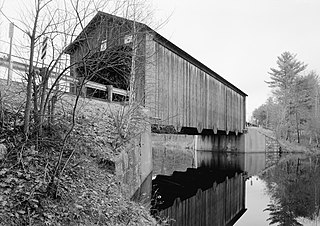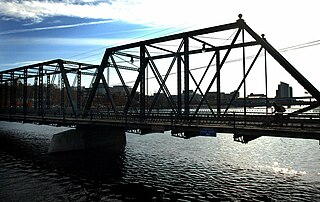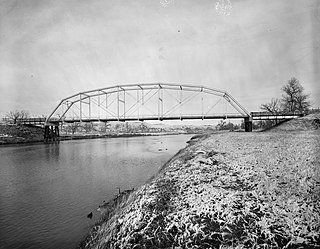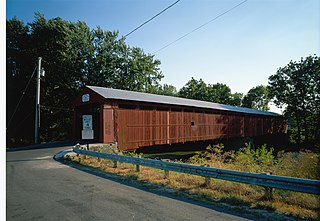
The Ohio and Erie Canal was a canal constructed during the 1820s and early 1830s in Ohio. It connected Akron with the Cuyahoga River near its outlet on Lake Erie in Cleveland, and a few years later, with the Ohio River near Portsmouth. It also had connections to other canal systems in Pennsylvania.

The Detroit–Superior Bridge is a 3,112-foot-long (949 m) through arch bridge over the Cuyahoga River in Cleveland, Ohio. The bridge links Detroit Avenue on Cleveland's west side and Superior Avenue on Cleveland's east side, terminating west of Public Square. Construction by the King Bridge Company began in 1914 and completed in 1918, at a cost of $5.4 million. It was the first fixed high level bridge in Cleveland, and the third high-level bridge above the Cuyahoga. At the time of its completion, the bridge was the largest steel and concrete reinforced bridge in the world.

The Laughery Creek Bridge is a triple Whipple truss bridge on the border of Dearborn County, Indiana, and Ohio County, Indiana. It crosses Laughery Creek. This bridge was built in 1878. The Wrought Iron Bridge Company, a prolific late 19th-century bridge company, constructed the bridge. The bridge is seated on stone abutments. The deck surface is not original and is currently concrete. The bridge, nearly 300 feet (91 m) in length, is a single-span, pin-connected, triple-intersection Whipple through truss, and is the only example in the world of this truss type. The name bridge's nickname, "Triple Whipple Bridge" is a play on words. The double-intersection Pratt, which was called the Whipple truss configuration, was a far more common variation of the standard Pratt configuration. Since the Laughery Creek Bridge's members have three intersections instead of two, this gives rise to the "Triple Whipple" name. This bridge was listed on the National Register of Historic Places in 1976.

Shaw Bridge, also known as Double-Span Whipple Bowstring Truss Bridge, is a historic bridge in Claverack, New York, United States. It carried Van Wyck Lane over Claverack Creek, but is now closed to all traffic, even pedestrians. It is "a structure of outstanding importance to the history of American engineering and transportation technology." Specifically designed by John D. Hutchinson, the bridge employs the basic design of Squire Whipple. It is the only extant "double" Whipple bowstring truss bridge in the U.S., having two identical spans placed in series over a common pier.

The Lilley Road—Lower Rouge River Bridge is an automotive bridge located on Lilley Road over the Lower River Rouge in Canton, Michigan. It was listed on the National Register of Historic Places in 2000.

The Hancock–Greenfield Bridge is a historic covered bridge carrying Forest Road over the Contoocook River at the town line between Hancock and Greenfield, New Hampshire. The New Hampshire Department of Transportation covered bridge database refers to it as County Bridge. Built in 1937, it is the first wooden covered bridge in the northeastern United States to use modern engineering techniques. The bridge was listed on the National Register of Historic Places in 1981.

The Massillon Bridge Company, most commonly abbreviated Massillon Bridge Co., was located in Massillon, Ohio and founded by Joseph Davenport in 1869. The company became incorporated in 1887 and remained in operation through the early 1900s. Steel truss bridges built by the Massillon Bridge Co. can be found throughout the midwest.

The Pine Mill Bridge is an historic structure located in Wildcat Den State Park in rural Muscatine County, Iowa, United States. It was built in 1878 near the Pine Creek Gristmill, the only place in Iowa where a mill and bridge combination remains in place. The bridge was listed on the National Register of Historic Places in 1998 as a part of the Highway Bridges of Iowa MPS.

The Upper Paris Bridge is an historic structure located near the town of Coggon in rural Linn County, Iowa, United States. The pin-connected Whipple through truss bridge was built in 1879 as a wagon bridge. It was designed by the Wrought Iron Bridge Company of Canton, Ohio. The bridge was listed on the National Register of Historic Places in 1998 as a part of the Highway Bridges of Iowa MPS.

The Brecksville-Northfield High Level Bridge is a bridge in Greater Cleveland, Ohio, U.S., connecting Brecksville in Cuyahoga County with Sagamore Hills Township in Summit County. It is located in the Cuyahoga Valley National Park.

The EDZ Irigary Bridge is a historic Pennsylvania truss bridge in southeastern Johnson County, Wyoming. The bridge was built in 1913 at Sussex, Wyoming, and moved in 1963 to Irigary Road. The bridge was listed on the National Register of Historic Places in 1985 as part of a Multiple Property Submission devoted to historic bridges in Wyoming.

The AJX Bridge is a historic Pratt truss bridge in southwestern Johnson County, Wyoming. The bridge was built in 1931 across the South Fork of the Powder River near Kaycee, Wyoming. AJX Bridge was built to provide a river crossing for U.S. Route 87. It was placed on the National Register of Historic Places in 1985 as part of a Multiple Property Submission devoted to historic bridges in Wyoming.

The Eldean Covered Bridge is a historic covered bridge spanning the Great Miami River in Miami County, Ohio north of Troy. Built in 1860, it is one of the nation's finest surviving examples of a Long truss, patented in 1830 by engineer Stephen H. Long. At 224 feet (68 m) in length for its two spans, it is the longest surviving example of its type. It was listed on the National Register of Historic Places in 1975, and was designated a National Historic Landmark in 2016.

Linville Creek Bridge is a historic Thacher truss bridge located near Broadway, Rockingham County, Virginia. It was built by the Wrought Iron Bridge Company in 1898. It is a single span, measuring 135 feet 11 inches (41.43 m) long. This bridge was formerly identified as a hybrid Whipple, incorporating aspects of both the double-intersection Pratt and the double-intersection Warren. The structure in actuality is a Thacher truss, a hybrid configuration incorporating elements of the Pratt, Warren, Fink, and Bollman trusses that was first patented by Edwin Thacher in 1883. Its unusual configuration and the bewildering number of descriptions that have been applied to it merely reinforce its position as a bridge that is a rare survivor of an uncommon form.

The Mountain Fork Bridge is a historic bridge in rural Polk County, Arkansas. It carries County Road 38 across Mountain Fork Creek north of Hatfield and southwest of Mena. The bridge consists of two spans of steel Pratt pony trusses, with a total length of 406 feet (124 m), including approach spans. The trusses are set on piers consisting of steel rings filled with concrete; each of these spans is 80 feet (24 m) long. The bridge's construction date and builder are unknown; it predates the standardization of bridge designs in the state in 1923. It is estimated to date to the early 1900s.

The Scenic Bridge crossing Clark Fork River about 4 miles (6.4 km) east of Tarkio in Mineral County, Montana, was built in 1928. It is located at Milepost 0 on Old U.S. Route 10 West. The bridge has also been denoted 24MN304 and MDT No. L31012000+08. It was listed on the National Register of Historic Places in 2010.

The New Hampton Pony Pratt Truss Bridge is a historic pony Pratt truss bridge on Shoddy Mill Road in New Hampton of Lebanon Township, Hunterdon County, New Jersey. It crosses the Musconetcong River between Lebanon Township, Hunterdon County and Washington Township, Warren County. It was designed by Francis C. Lowthorp and built in 1868 by William Cowin of Lambertville, New Jersey. The bridge was added to the National Register of Historic Places on July 26, 1977 for its significance in engineering, industry and transportation. It is one of the few early examples of iron Pratt truss bridges remaining in the United States. It was later documented by the Historic American Engineering Record in 1991. It was added as a contributing property to the New Hampton Historic District on April 6, 1998.

The Main Street Bridge, once known as the West Main Street Bridge, is a historic pony Pratt truss bridge crossing the South Branch Raritan River in Clinton of Hunterdon County, New Jersey. It was designed by Francis C. Lowthorp and built in 1870 by William Cowin of Lambertville. The bridge was added to the National Register of Historic Places on September 28, 1995 as part of the Clinton Historic District. It is one of the few early examples of iron Pratt truss bridges remaining in the United States. It was documented by the Historic American Engineering Record in 1991.

The Glen Gardner Pony Pratt Truss Bridge is a historic pony Pratt truss bridge on School Street crossing the Spruce Run in Glen Gardner of Hunterdon County, New Jersey. It was designed by Francis C. Lowthorp and built in 1870 by William Cowin of Lambertville, New Jersey. The bridge was added to the National Register of Historic Places on September 22, 1977 for its significance in engineering, industry and transportation. It is one of the few early examples of iron Pratt truss bridges remaining in the United States. It was later documented by the Historic American Engineering Record in 1991.




















